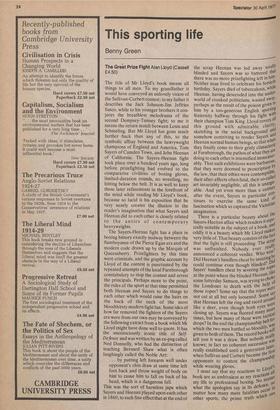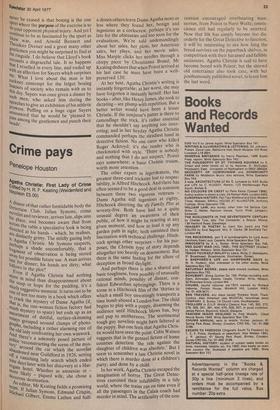This sporting life
Benny Green
The Greet Prize Fight Alan Lloyd (Cassell £4.50) The title of Mr Lloyd's book means all things to all men. To my grandfather it would have conveyed an unlovely vision of the Sullivan-Corbett contest; to my father it describes the Jack Johnson-Jim Jeffries fiasco, while to his younger brothers it conjures the breathless melodrama of the second Dempsey-Tunney fight; to me it means the return match between Louis and Schmeling. But Mr Lloyd has gone much further back than any of this, to the symbolic affray between the heavyweight champions of England and America, Tom Sayers of Camden Town, and John Heenan of California. The Sayers-Heenan fight took place over a hundred years ago, long before prizefighting had evolved to the comparative civilities of boxing gloves, limited-duration rounds, no wrestling, no hitting below the belt. It is as well to keep these later refinements in the forefront of the mind while reading Mr Lloyd's book, because so lucid is his exposition that he very nearly creates the illusion in the reader's imagination that what Sayers and Heenan did to each other is closely related to the antics of contemporary heavyweights.
The Sayers-Heenan fight has a place in boxing history exactly midway between the flamboyance of the Pierce Egan era and the modern code drawn up by the Marquis of Queensberry. Prizefighters by this time were criminals, and the graphic account by Lloyd of the contest is punctuated by the repeated attempts of the local Farnborough constabulary to stop the contest and arrest the principals. Perhaps more to the point, the rules of the sport at that time permitted both Heenan and Sayers to do things to each other which would raise the hairs on the back of the neck of the most bloodthirsty modern fight fan. Some idea of how far removed the fighters of the Sayers era were from our own may be conveyed by the following extract from a book which Mr Lloyd might have done well to quote. It has the unconsciously ironic title of SelfDefence and was written by an ex-pug called Ned Donnelly, who had the distinction of teaching Bernard Shaw what is often laughingly called the Noble Art: . . . by putting left forearm well under opponent's chin draw at same time left foot back and throw weight of body on him-to cause him to fall on back of his head, which is a dangerous fall.
This was the sort of harmless jape which Sayers and Heenan played upon each other in 1860, to such fine effect that at the end of
the scrap Heenan was led away totahY blinded and Sayers was so battered that there was no more prizefighting left in hinl• Neither man lived to celebrate his fortieth birthday. Sayers died of tuberculosis, while Heenan, having descended into the under" world of crooked politicians, wasted away' perhaps as the result of the poison given to him by a too-generous English sporting fraternity halfway through his fightwit!! their champion Tom King. Lloyd covets aa this ground with admirable claritY, sketching in the social background and, somehow contriving to render Sayers an' Heenan normal human beings, so that when they finally come to their grisly climacteric at Farnborough, the pathos of what theY are doing to each other is intensified immeasur" ably. That such exhibitions were barbarous, that they were doomed to proscription bY the law, that their ethics were contemPtible: their after-effects often fatal, their so-calien art invariably negligible, all this is unargoable. And yet even more than a centarY after the event, Sayers in particular coni tinues to exercise the same kind,_, fascination which so captured the Victoria" imagination. There is a particular beauty about the Sayers-Heenan affair which renders it esPeddaily suitable as the subject of a book, an s oddly it is a beauty which Mr Lloyd mal‘et very little of. That beauty consists of the fae that the fight is still proceeding. The scrap was unfinished. Nobody ever realY, announced a coherent verdict. Who vv°11, Did Heenan's handlers cheat by insist1.'d could continue even though blinded? 13 s Sayers' handlers cheat by severing the ropee at the point where the blinded Heenan.libk, some latterday Samson, was trying to choi`o`i the Londoner to death with the helP those ropes? Some say that the ropes we v not cut at all but only loosened. Some 55ii that Heenan left the ring and raced ar°unt.e like a deer, even though both eyes vinere closing up. Sayers was floored marl)/r(1.-cat times, but how many of these were wow,. drops? In the end the championshiP which the two men battled so bloodilY, given to both of them. The record books viiiv tell you it was a draw. But nobody rea knows; in fact no coherent succession We'r, really established until a generation lafirst when Sullivan and Corbett became the h ip opponents to contest the champions while wearing gloves.
I must say that my reactions to L
book are as ambivalent as my reactionst:Ier my life to professional boxing. No lila no what the apologists say in its defence,i P l
matter how many more fatalities occucari other sports, the prime truth which matter how many more fatalities occucari other sports, the prime truth which
'lever be erased is that boxing is the one AsPcn't where the purpose of the exercise is to uc' Your opponent physical injury. And yet I, ccquinue to be as fascinated by the sport as Shaw was, and Arnold Bennett and Theodore Dreiser and a great many other gentlemen you might be surprised to find at the ringside. I do believe that Lloyd's book recounts a disgraceful tale. It so happens that I revelled in every line, and ended up with an affection for Sayers which surprises lie. What I love about the man is his cockney contempt for the fatgut boxing fanciers of society who remain with us to this day. Sayers was once given a dinner by such men, who asked him during the sPeeches to give an exhibition of his athletic prowess. Puffing on a huge cigar Sayers announced that he would be 'pleased to pass among the gentlemen and punch their n▪ eads,.



































 Previous page
Previous page